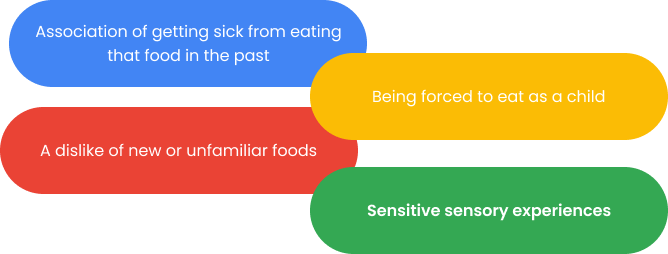Adventurous Eater
Creating a positive mealtime experience for young teens by reshaping their negative food perceptions
Intrigued by the domain of behavior change design, I designed a voice agent that encourages young teenagers to eat more healthy by challenging their perception of food. This was my first independent Conversational UI project, which allowed me to adopt diverse conversation design principles in the design.
OVERVIEW
TIMELINE
April - May 2021
INDEPENDENT PROJECT
Research
Content Development
Conversation Design
Prototyping
PROJECT FOCUS
Voice assistant, Conversational User Interface, Voice User Interface
BACKGROUND
An independent project from Dr. Paul Pangaro’s class Designing for Conversation: Theories, Models, and Making in CMU’s Human-Computer Interaction Institute.
THE CHALLENGE
How might we encourage young teens to eat more healthy?
In the US, around 39% of children are picky eaters and about half that number will remain selective into their teens and beyond; And 26% of adults self-identify as picky eaters.
(Mascola, A. J., Bryson, S. W., & Agras, W. S. (2010). Picky eating during childhood: a longitudinal study to age 11 years. Eating behaviors, 11(4), 253-257.)
THE SOLUTION
A therapist-like voice assistant that transforms your mealtime experience
A friendly conversational companion stepping into the role of a virtual therapist, encouraging open dialogues with young teens as they candidly express their food aversions. Through these conversations, they’re gently nudged to see the foods they dislike in a fresh and positive light.
RESEARCH
INSPIRATION FROM BACKGROUND RESEARCH
Food aversion is a psychological repulsion...which means it’s all in your head and it’s possible to overcome!

Have you noticed that there are certain foods that you weren't able to eat as a child but now can eat?
As you become adults, you become desensitized to the textures, flavors, and smells of food, but kids have not yet. This is due to their brain processing the touch, taste, or smell of food as “displeasurable.”
Yet, children’s brains are extremely malleable and there is a chance of them being able to learn new things and ultimately behave differently.
This inspired me to target young teenagers (ages around 10-12) who start to have greater autonomy in their own behaviors and at the same time, are still adaptable enough when guided in a certain way.
Transforming the negative perception of food to a positive
If the way children respond to foods is simply the result of sensory input overload with them having difficulty processing the different aspects of eating, I wondered if I could apply a psychological tactic to replace their “negative perception of food” with “positive ones.”
DESIGN PROCESS
CONVERSATION LOGIC
DESIGN PRINCIPLES
What makes a great conversational partner?
Cybernetic Design (Axioms of Interactions for Conversation v2.0 - Paul Pangaro)
Cooperative
When sequences of coherent interactions enable participants to evolve their points of view such that agreement may arise.
“Why don't you make eggplant sour? You might enjoy the added quality of the eggplant!”
Ethical
When there is reliable transparency of action & intent — what + why — such that trust may arise.
“Recently, scientists found that as you get older, you become desensitized to the textures, flavors, and smells of food. Our brain just needs time to process these sensory inputs! So don’t worry if you don’t like a certain food.”
Humane
When any participant may influence its direction such that collaboration may arise.
“Many people I’ve talked to also didn’t like eggplant.”
Goals and Means
I applied Goals and Means modeling to design conversation, which enables me to think of turns in a conversation as negotiating goals and the means to achieve them.
Among the four different modes of conversation, I used guiding and collaborating as the main mode of conversation.
Guiding - B sets goal but discusses means with A
Collaborating - A and B decide together on goals
CONVERSATION FLOW
PROTOTYPING
I used Voiceflow to prototype the conversation flow.
REFLECTION
MY KEY TAKEAWAYS
Be more explorative
Instead of limiting the conversation to transactional (e.g. Q & A), a more natural human-like conversation needs to be incorporated into the design. One of the challenges I had throughout this project was the conflict between technical practicality vs. being more exploratory. I was initially too focused on the technical practicality of the current technology (voiceflow) that it limited certain way I designed the conversation.
Design a Cooperative, Ethical, Humane UI
In addition to considering goals and means, thinking about how to design a conversational UI that is cooperative, ethical, and humane (applications of cybernetics) guided me a lot throughout this project as I tried to incorporate those components in the design.
Why a CUI
Always ask “why my solution has to be a CUI” instead of screen-based UI or other interface and incorporate qualities that make for an “effective” and “valuable” conversation: a conversation that delights you by helping you to learn something new, generative, and evolves in ways you couldn’t evolve on your own.







